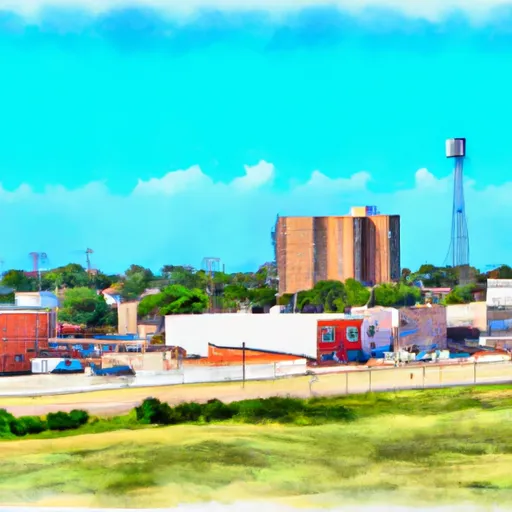-
 Snoflo Premium
Snoflo Premium
Get unlimited access to all our content
With no Ad interruptions! - Start Your Free Trial Login with existing account
Roscoe
Eden Index
Climate
9.5
•
Recreation
•
Community
2.7
•
Safeguard
4.5/10

Roscoe, Texas is a small town located in Nolan County, in the western part of the state. The climate in Roscoe is classified as semi-arid, characterized by hot summers and mild winters. Summers are typically hot with temperatures often exceeding 90°F, while winters are generally mild with temperatures rarely dropping below freezing. The region receives relatively low annual precipitation.
In terms of hydrology constituents, Roscoe is situated near the Colorado River and the E.V. Spence Reservoir, providing a reliable water source for the community. The area is known for its agricultural activities, primarily cotton farming.
For outdoor recreation enthusiasts, Roscoe offers several opportunities. The nearby Lake Sweetwater provides opportunities for fishing, boating, and water sports. The area also has numerous parks and trails, perfect for hiking and picnicking. The nearby Nolan River is a popular spot for kayaking and canoeing, while hunters can explore the local wildlife management areas for deer, turkey, and dove hunting. Overall, Roscoe's climate, hydrology constituents, and outdoor recreation opportunities make it an attractive destination for nature lovers and those seeking outdoor adventures.
What is the Eden Index?
The Snoflo Eden Index serves as a comprehensive rating system for regions, evaluating their desirability through a holistic assessment of climate health, outdoor recreation opportunities, and natural disaster risk, acknowledging the profound impact of these factors on livability and well-being.
Climate Health Indicator (CHI): 9.5
Roscoe receives approximately
567mm of rain per year,
with humidity levels near 75%
and air temperatures averaging around
18°C.
Roscoe has a plant hardyness factor of
7, meaning
plants and agriculture in this region tend to thrive during the non-winter months.
By considering the ideal temperature range, reliable water supplies, clean air, and stable seasonal rain or snowpacks, the Climate Health Indicator (CHI) underscores the significance of a healthy climate as the foundation for quality living.
A healthy climate is paramount for ensuring a high quality of life and livability in a region, fostering both physical well-being and environmental harmony. This can be characterized by ideal temperatures, reliable access to water supplies, clean air, and consistent seasonal rain or snowpacks.
Weather Forecast
Streamflow Conditions
Middle Brazos-Clear Fork
Area Rivers
Middle Brazos-Clear Fork
Snowpack Depths
Middle Brazos-Clear Fork
Reservoir Storage Capacity
Middle Brazos-Clear Fork
Groundwater Levels
Recreational Opportunity Index (ROI):
The Recreational Opportunity Index (ROI) recognizes the value of outdoor recreational options, such as parks, hiking trails, camping sites, and fishing spots, while acknowledging that climate plays a pivotal role in ensuring the comfort and consistency of these experiences.
Access to outdoor recreational opportunities, encompassing activities such as parks, hiking, camping, and fishing, is crucial for overall well-being, and the climate plays a pivotal role in enabling and enhancing these experiences, ensuring that individuals can engage in nature-based activities comfortably and consistently.
Camping Areas
| Campground | Campsites | Reservations | Toilets | Showers | Elevation |
|---|---|---|---|---|---|
| Paint Creek Park - Spence Reservoir | 10 | 1,925 ft | |||
| Water Valley County Park | 18 | 2,071 ft | |||
| Twin Buttes Park | None | 1,946 ft | |||
| Equalization Channel - Twin Buttes Reservoir | None | 1,956 ft | |||
| Goodfellow AFB Military | None | 1,879 ft | |||
| Middle Concho Park | None | 1,880 ft | |||
| Spring Creek Marina & RV Park - San Angelo | 83 | 1,873 ft | |||
| Wildcat Park - Spence Reservoir | 14 | 1,932 ft | |||
| Robert Lee City Park | 8 | 1,842 ft | |||
| San Angelo State Park | 200 | 1,944 ft |
Nearby Ski Areas
Catastrophe Safeguard Index (CSI):
The Catastrophe Safeguard Index (CSI) recognizes that natural disaster risk, encompassing floods, fires, hurricanes, and tornadoes, can drastically affect safety and the overall appeal of an area.
The level of natural disaster risk in a region significantly affects safety and the overall livability, with climate change amplifying these risks by potentially increasing the frequency and intensity of events like floods, fires, hurricanes, and tornadoes, thereby posing substantial challenges to community resilience and well-being.
Community Resilience Indicator (CRI): 2.7
The Community Resilience Indicator (CRI) recognizes that education, healthcare, and socioeconomics are crucial to the well-being of a region. The CRI acknowledges the profound impact of these elements on residents' overall quality of life. By evaluating educational resources, healthcare accessibility, and economic inclusivity, the index captures the essential aspects that contribute to a thriving community, fostering resident satisfaction, equity, and social cohesion.

